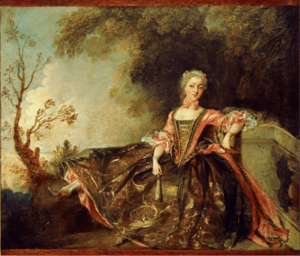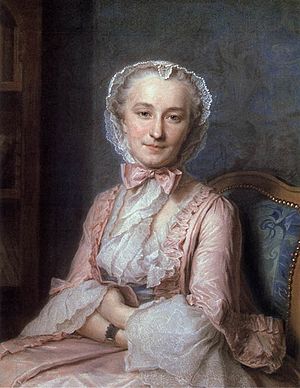Marie Sallé facts for kids
Marie Sallé (1707–1756) was a French dancer and choreographer from the 1700s. She was known for her emotional and dramatic performances. This was different from the usual "leaps and frolics" seen in ballet back then.
Contents
Marie Sallé's Life and Career
Marie Sallé was a very important dancer and choreographer in the early 1700s. She helped create a new type of ballet called ballet d'action. This style focused on telling a story through dance. She also changed how dancers dressed on stage.
Early Life and Performances
Marie was born in 1707. Her parents were performers who worked at fairs. She grew up performing all over France with her family.
She first performed publicly in London in 1716. This was with her brother, Francis, at the Lincoln's Inn Fields Theatre. They later performed in Paris in 1718. They danced in a show called La Princesse Charisme. The siblings also studied with famous dancers like Claude Balon and Françoise Prévost. They spent more time performing in London. They danced in operas by George Frideric Handel and in pantomimes.
Solo Career and Famous Works
Sallé started performing alone with the Paris Opera in 1727. She danced in a show called Les Amours des Dieux. She sometimes danced with Marie Camargo, another student of Prévost. But they had different styles. Camargo was known for her technique, while Sallé was known for her acting.
Sallé left the Paris Opera three times because of disagreements. But she still made a big impact there. She worked with the composer Jean-Philippe Rameau. In 1734, she went back to London. She performed at Covent Garden. She danced in Handel's operas like "Alcina" and "Ariodante."
In 1734, Sallé created her first original ballet, Pygmalion. This was a story from Greek myths about a statue that comes to life. She was the first woman to choreograph a ballet and also dance in it. In Pygmalion, Sallé wore simple Greek robes. She let her hair down and danced in sandals. She wanted to make the character of the statue seem more real. Her dancing made it look like a "danced conversation." During this time, she also created another show called Bacchus and Ariadne.
She returned to Paris in 1735. There, she choreographed and danced in shows for Jean-Phillipe Rameau. She stopped performing publicly in 1741. However, she still danced for royalty at court. She also taught at the Opéra-Comique in 1743. Her student, Jean-Georges Noverre, said she practiced every day. Sallé performed a few more times at Versailles between 1745 and 1747. She passed away on June 27, 1756.
How People Saw Her
In the 1700s, men usually held the most important jobs in theaters. Women were often seen as just performers. Marie Sallé was different because she was also a choreographer. She created her own shows in London and Paris. But her achievements were sometimes judged more harshly than those of men.
In her early career, people often described her as "pure." She was even called "La Vestale," like the ancient Roman priestesses. The painter Nicolas Lancret painted her as the goddess Diana. This helped create her public image. After her role in Jean-Philippe Rameau's Les Indes Galantes in 1735, images of roses were also linked to her.
Sallé retired when she was 33. After she left the public eye, people wrote less about her. Later in life, Sallé lived with a friend, Rebecca Wick. Five years before she died, Sallé left all her belongings to Rebecca Wick.
Marie Sallé's Costume Reforms
Marie Sallé was a choreographer and performer. But she also started a new way of thinking about costumes in dance. Her student, Jean-Georges Noverre, later continued these ideas.
New Ideas for Costumes
Sallé believed that dancers should not wear masks. She thought that dance and costumes should look like real life. She argued that costumes should fit the character. This was a new idea at the time. This made performances feel more "realistic." It also gave female dancers more freedom to move. They no longer had to wear heavy, fancy clothes. Noverre quickly adopted these ideas.
Challenges and Successes
Sallé's costume ideas were seen as too extreme in France. The dance world in France was very strict. So, dancers often went to other countries to develop their art. London was a popular choice because it was more open to new ideas. Sallé was one of these dancers. London audiences liked new things in dance. Sallé's acting skills fit well with the open-minded audiences there.
In London, she created her most famous show, Pygmalion. When she performed in it, she did not wear a pannier. A pannier was a wide skirt that was typical for women's costumes. French critics were shocked that she dared to appear without a skirt, headdress, or even a corset.
Despite this criticism, Sallé kept pushing for realistic costumes. In Handel's Alcina, she wore what was called "male attire." This went against the usual feminine look of dancers. She changed the heavy, long dresses to light, flowing material. This caused both shock and delight. She often performed without a skirt or bodice. This was her way of rebelling against traditional costumes and strict gender rules of the time.
Critics often linked Sallé's costume changes to the male-dominated theater world. Men in power expected women to be graceful and obedient. They criticized female creators who did not fit this idea of femininity. But Sallé slowly gained respect for her work. She worked with famous composers like George Frideric Handel and Christoph von Gluck. They wrote music for her dances.
Images for kids
See also
- Women in dance





